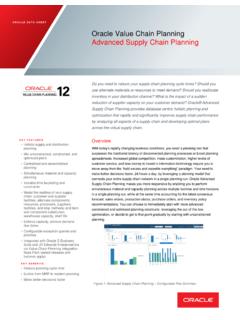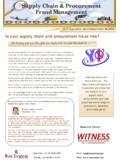Transcription of Chain reaction: how blockchain technology could ...
1 Chain reaction: how blockchain technology could revolutionize the finance function What is a blockchain ? Of the many strands of digital disruption shaking up financial services, blockchain technology is one of the most fascinating. Although it's still in its early stages of development with practical applications in financial services focused mainly on payments and From executing capital planning exchange blockchain will revolutionize the way the finance to producing liquidity reports, function operates. there are many tasks that As Sir Mark Walport, the UK Government's Chief Scientific Adviser, said in the report Distributed Ledger technology : beyond block blockchain technology could help banks with. Chain : We may be witnessing one of those explosions of creative potential that catalyze exceptional levels of innovation.. In financial services, that innovation could , for example, allow organizations to publish data simultaneously, enabling them to minimize reconciliation and automate accounting, which would save both time and money.
2 But what, exactly, is a blockchain ? Building blocks A blockchain is a type of database that takes a number of records and puts them in a block (rather like collating them on to a single sheet of paper). Each block is then chained to the next block, in a linear, chronological order, using a cryptographic signature. This process allows blockchains to be used as ledgers, which can be shared and corroborated by anyone with the appropriate permissions. These distributed ledgers can be spread across multiple sites, countries or institutions. Transaction Easy-to-track transactions, The accuracy of all transactions providing the ability to and subsequent accounting investigate balances at the entities are maintained through source transaction. cryptography mathematics. Time 02 | Chain reaction: how blockchain technology could revolutionize the finance function Transforming the finance function Finance functions in financial services institutions continue to be need for the standard reporting cycles across statutory, regulatory characterized by complex issues constraining finance professionals' and management reporting.
3 Ability to provide timely and accurate information to internal stakeholders, shareholders and regulators. At EY, we believe Inter company transparency: By creating just one version of blockchain technology has the potential to significantly reduce these the ledger, blockchain technology would allow inter company issues for finance functions. At the heart of these solutions is the transparency and the opportunity for simultaneous settlement. shared ledger, which each party needing to see financial data will need This would free up time for the finance function to focus on to access. All copies of the ledger are simultaneously updated, ensuring added-value activities such as strategic planning and supporting identical copies, with no ledgers or versions of data out of sync. Such wider business decisions, particularly at the critical period of the final shared ledgers could be applied within financial services institutions stages of the consolidation process.
4 Across their businesses, legal entities and divisions as well as across a consortium of banks. Reconciling transactions: EY estimates that, within a typical finance team at banks and insurers, between 50 and 100 working From executing capital planning to producing liquidity reports, there days are lost each month reconciling differences. Adopting a are many tasks that financial services institutions' finance functions shared ledger approach will help, by enabling all parties concerned carry out that blockchain will simplify. Here are just four of these to identify the same transactions at source, with data being challenges encountered by finance functions that we think the published simultaneously significantly reducing the number technology will impact directly. of reconciliations required. Delivery of statutory, management and regulatory reporting: Maintaining financial data standards: Most of our clients take several Slow and inaccurate reporting data can lead to poor decision-making, months to reflect organizational structure changes within their additional delivery costs and even unnecessary capital funding.
5 With finance systems. But with blockchain , any changes to the ledger blockchain , data would be published simultaneously, removing the would be reflected in all copies in minutes, allowing for financial data How would the ledger operate? Each participant would ultimately access the same ledger. All copies of the ledger would be simultaneously updated ensuring identical copies of the ledger, with no ledgers or versions of data out of sync. The shared ledger could be applied to a consortium of banks or even applied to one multiple group financial institution. A single blockchain With a shared ledger, data is The distributed ledger validated at the source and is difficult to corrupt, helping to combat fraud and allowing for accurate and complete information. 03 | Chain reaction: how blockchain technology could revolutionize the finance function Applying the technology standards such as charts of accounts and reporting hierarchies Adopting blockchain to be updated easily.
6 Despite the possibilities, it's important to remember that blockchain is a very new technology . As a result, there are only a small number Ensuring source system accuracy of instances in which the technology has been applied to the finance blockchain technology possesses a number of characteristics that can function. ensure financial data is accurate, secure and simple to analyze. There are also a number of factors that could deter financial services The technology can make transactions easy to track, making it possible organizations from adopting blockchain technology . to investigate balances at the source transaction. The accuracy of all transactions and subsequent accounting entities are maintained One is scalability. blockchain is likely to require a single, centralized through cryptography mathematics. database if binary traditional computer systems are applied;. implementing blockchain could prove to be costly. And with a shared ledger, data is validated at the source, making it difficult to corrupt, which helps to prevent fraud and ensure data is Another is the cost of migration.
7 Moving from legacy finance systems both accurate and complete. is likely to require significant investment from organizations. Implementing blockchain Which finance function tasks is blockchain most capable of revolutionizing, and in which areas is the technology easiest to implement? Area of application Ability to revolutionize Complexity of implementation Very low Very high Very low Very high Improve business decision support by delivering planning, budgeting and forecasting, capital planning, and supporting business pricing decisions. Deliver mandatory external reporting. Produce management reporting. Record business transactions, including reconciling financial transactions to source. Maintain financial data standards such as chart of accounts, cost and profit centers and reporting hiearchies. Provide consolidated views such as balancing inter company position and delivering group-consolidated view. Execute financial accounting: deliver product accounting, account for accruals and prepayments and account for impairments.
8 04 | Chain reaction: how blockchain technology could revolutionize the finance function Exploring its potential The potential rewards from adopting blockchain , though, are likely to far outweigh the cost of migration. At first, banks may well Ultimately, blockchain could help decide to adopt a modular approach that allows them to use blockchain within their organization, but has the potential to be you to create a faster, cheaper, expanded for intercompany use. For a fully shared ledger to work, it would require a consortium of banks to participate, with all more efficient and more banks agreeing to adopt the technology in a similar time frame to one another. transparent finance function. While it might take time for organizations to realize the full benefits of blockchain , the technology 's potential for transforming financial services is unlimited. Because of this, at EY we're already working to understand fully how blockchain could be applied to the finance function and we recommend that you too (if you haven't already) start playing with the technology and exploring how you could adopt it in your organization, rather than waiting and having to react later on.
9 Because, ultimately, blockchain could help you to create a faster, cheaper, more efficient and more transparent finance function. Key contacts Christophe Kasolowsky Liam McLaughlin Emma Weston Imran Gulamhuseinwala Partner, EMEIA Financial Partner, EMEIA Financial Senior Manager, EMEIA Financial Partner, Global FinTech Leader Services, Finance Services, Finance Services, Finance Transformation Tel: +44 20 7980 9563. Transformation Leader technology Leader and technology Email: Tel: +44 20 7951 0419 Tel: +44 20 7951 3796 Tel: + 44 20 7951 2020 Email: Email: Email: 05 | Chain reaction: how blockchain technology could revolutionize the finance function EY | Assurance | Tax | Transactions | Advisory About EY. EY is a global leader in assurance, tax, transaction and advisory services. The insights and quality services we deliver help build trust and confidence in the capital markets and in economies the world over. We develop outstanding leaders who team to deliver on our promises to all of our stakeholders.
10 In so doing, we play a critical role in building a better working world for our people, for our clients and for our communities. EY refers to the global organization, and may refer to one or more, of the member firms of Ernst & Young Global Limited, each of which is a separate legal entity. Ernst & Young Global Limited, a UK company limited by guarantee, does not provide services to clients. For more information about our organization, please visit EY is a leader in serving the financial services industry. We understand the importance of asking great questions. It's how you innovate, transform and achieve a better working world. One that benefits our clients, our people and our communities. Finance fuels our lives. No other sector can touch so many people or shape so many futures. That's why globally we employ 26,000 people who focus on financial services and nothing else. Our connected financial services teams are dedicated to providing assurance, tax, transaction and advisory services to the banking and capital markets, insurance, and wealth and asset management sectors.














